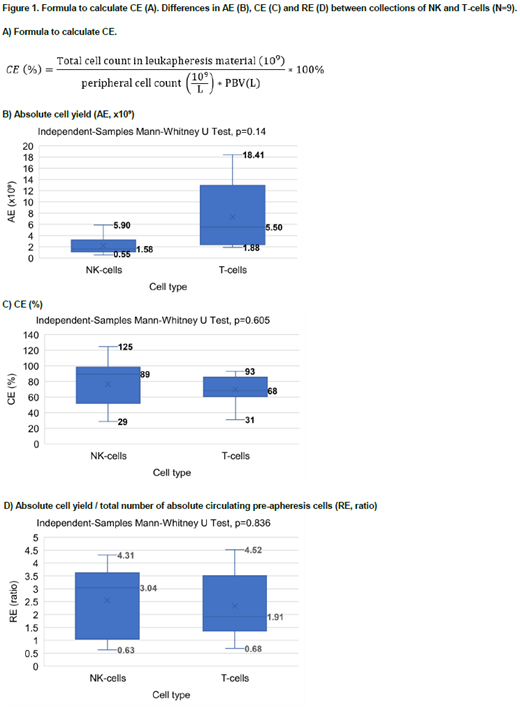Abstract
Background:
Natural killer (NK) cell-based immunotherapies are emerging as a new, cutting-edge, promising cancer treatment. NK cells have been used to generate autologous as well as allogenic chimeric antigen receptor NK (CAR-NK) cells, and are currently being tested in multiple clinical trials. The advantage of these cells over CAR-T cells is that they show a superior toxicity profile, less on-target/off-tumor effects, and their toxicity mechanism could be independent of CAR. Additionally, allogenic CAR-NK cells are less immunogenic and cause less graft versus host disease in comparison to CAR-T cells. NK-cell collection during apheresis is the first step in the production of CAR-NK-cells. Efficient collection of NK-cells is paramount to successful manufacture of a CAR-NK cell product. Here, we present our single-center experience on individualized high-flow autologous lymphocyte apheresis in heavily pre-treated patients who qualified for a CAR-T treatment. In this abstract, we demonstrate data on NK-cell collections that derived from our research on T-cell collections.
Study design and methods:
In this retrospective, descriptive study, we compared collection efficiencies (CE%), absolute efficiencies (AE; absolute yield) and relative efficiencies (RE; AE/total number of absolute circulating pre-apheresis cells) for NK- and T-cell collections. Recruitment of cells was assumed if RE>1. The analysis was performed for 9 heavily pre-treated diffuse large B-cell lymphoma patients who underwent autologous T-cell collections for CAR-T treatment between October 2018 and November 2019. These 9 patients were chosen because the data on pre-apheresis NK- and T-cell concentrations, and harvest NK- and T-cell yield, were available for them. For calculation of CE% a standard formula was used (Figure 1, A).
Results:
A total of 9 high-flow lymphocyte collections achieved the cell yield of 1x10 9 cells for T- cells and 88% (n=8) achieved the cell yield of 1x10 9 cells for NK-cells. The median pre-apheresis cell concentration for NK-cells was 0.21 x10 9/L (range 0.05 - 0.29) and for T-cells was 0.69 x10 9/L (0.11 - 2.09). The median average blood flow was 77 ml/min (49 - 132), the median processed blood volume was 13.51L (7.35 - 31.17), while the median ratio of processed blood volume to total blood volume was 2.57 (1.46 - 6.67). The median AE for NK-cells with 1.58x10 9 (0.55 - 5.9) was markedly lower but not statistically significant (p=0.14) than that of T-cells with 5.5x10 9 (1.88 - 18.41). The CE of NK-collections was median 89% (29 - 125), while the CE of T-cell collections was median 68% (31 - 93) and they were not statistically different (p=0.605). The same was observed for RE which was 3.04 (0.63 - 4.31) for NK-cells and 1.91 (0.68 - 4.52) for T-cells with no statistically significant difference (Independent-Samples Mann-Whitney U Test, p=0.836). Figure 1 presents the differences in AE (B), CE (C) and RE (D) between NK- and T-cell collections.
Conclusions:
During high-flow lymphocyte apheresis, NK- as well as T-cells are recruited, as in the majority of collections the cell yield is greater than the absolute circulating pre-apheresis cell count (when RE was > 1). Thus, the origin and immunophenotype of these NK- and T-cells should be subject of further investigation. CE for NK- and T-cells are similar and high enough to perform efficient cell collections of both cell types for immunotherapy.
Jalowiec: Kite Pharma Gilead Sciences': Honoraria, Speakers Bureau. Daskalakis: Amgen: Other: Travel grant; Roche: Other: Travel grant; Gilead: Membership on an entity's Board of Directors or advisory committees, Other: Travel grant; Celgene/BMS: Consultancy, Other: Travel grant; Novartis: Membership on an entity's Board of Directors or advisory committees, Other: Travel grant; NovoNordisk: Other: Travel grant.


This feature is available to Subscribers Only
Sign In or Create an Account Close Modal